
Wine Culture and Information since 2002 - Volume 22
 Wine Culture and Information since 2002 - Volume 22 |
|
Issue 26, January 2005 |
Contents |
|
|
Tribute to Luigi Veronelli |
|
The 2004, the year which has just passed, ended with a grave loss for the world of Italian wine and - with no fear of doubt - for the whole world of wine. The last November 29th, in Bergamo - the city where he lived - at 78 has passed away Luigi Veronelli. The sad news deeply shocked the world of enology and with him we all lose the greatest - and the first - enogastronomical critic and divulger of our times. Whoever has been into wine for at least once in his or her life, knew who Luigi Veronelli was and the precious work he did for almost fifty years in favor of Italian wine, olive oil, the revaluation of agricultural resources and the country world. Luigi Veronelli - whose friends were used to call him “Gino” - has always tenaciously fought and with determination in favor of wine and against its homologation. For him wine - and it was enough to look at him with a glass of wine in his hands to understand this - has always been a dear and loyal friend, a friend to respect and to defend against the endless attempts of speculation. Whoever works in the wine business, as well as any lover of the beverage of Bacchus, knows that without his work and his revolutionary and pioneer ideas, the world of Italian wine would not be today what it is. Luigi Veronelli had the courage and the intuition of awakening the world of Italian enogastronomy from its long and deprecable sleeping, therefore giving back to Italy the conscience and cultural identity of its wine and foods, while promoting - the first one in our country - the long and hard way that from quantity led to quality. Luigi Veronelli was the first one to convince Italian wine producers - since 1960's - that great wines born in the vineyard. He was the first one who insisted on the absolute need of selecting grapes in the vineyard, to introduce the importance of terroir, to emphasize the potentials and differences of each vineyards and of each cru. He was the first one to believe Italian wine could improve in order to reach exceptional levels of quality: an idea on which - at those times - no one dared to believe and could not understand. All that in 1960's and 1970's, when quantity still was the main goal of Italian enology and quality was seen as an utopia. Luigi Veronelli has been a great pioneer. Moreover, he was a pioneer in the information and in the way of writing about wine: whoever is in the enogastronomy press and write about wine knows he or she owes to Luigi Veronelli the gratitude granted to a master. His many books, the countless articles published in journals and magazines, have taught anyone who had the pleasure to read them: his words have introduced to the world of wine countless lovers. His lexicon and his way of writing about wine, in his absolutely personal style, are now part of the description of wine and criticism parlance. Among the most famous ones it is impossible not to mention “meditation wine” and “fable wine”. With the loss of Luigi Veronelli we lost the fundamental and historical pillar for anyone writing about wine, an important reference point who taught anyone and strongly contributed to the spreading of enogastronomical press and information. Luigi Veronelli was born in Milan on February 2nd, 1926 and at about 25 he discovered his passion for the world of enogastronomy, at 30 he is the editor of “Il Gastronomo” (The Gastronomer) a philosophical-gastronomical magazine. The style he uses for writing about the many subjects - polemical and provocative - soon allowed him to notoriety and he wrote many books either alone or in collaboration with others. Luigi Veronelli was also a very popular TV personage in the 1960's and 1970's: unforgettable is the TV show “A tavola alle sette” together with Ave Ninchi, the great Italian actress too rapidly forgotten and that should be more frequently remembered. He has always been a strenuous opposer of the Italian DOC system - in which he saw a system in favor of commercial and industrial wineries - and he used to say that «the worst wine of a peasant is better than the best industrial wine». His last “battles” were in favor of Communal Denominations for food resources and source price as well as supporting the revaluation of olive oil production. His ideas - always tenaciously supported with determination - have had the “fault” of being told too early in respect of times, in moments in which no one could understand them, maybe because of the incapacity of looking beyond the horizon and the will to change things. Despite his ideas have been source of problems - even with law - and for which he found many friends, as well as many enemies, today, after tens of years, we know Luigi Veronelli was right. Italian wine owes much of its success in the world to his intuitions and to the cultural and enological revolution of which he indisputably was pioneer and leader. And the effects are still visible today even after more than thirty years. We all who love wine owe something to Luigi Veronelli. He was the first one to teach us how to “talk” and “listen' to wine, to revaluate its dignity and to understand its soul. Without his work, Italian wine would not be what it is today and certainly it would be said and written less about wine and of its vast world. We all owe you gratitude, dear master Luigi Veronelli, and we hope it will not be offensive if we dare to say goodbye in a friendly way - granting us the privilege of friendship - by means of the words of this small tribute to your person and to your work. Thank you Gino.
|
||||
MailBox |
|
In this column are published our reader's mail. If you have any comment or any
question or just want to express your opinion about wine, send your letters to
our editorial or fill in
the form available at
our site.
|
| I would like to know the characteristics of traditional Italian casks and the main difference from barrique besides volume. I also have another question: would it be appropriate for disciplinary to specify, besides the time of aging, the type of cask to be used in order to avoid the abuse of barrique? More and more frequently I see producers of “historical” wines, such as Brunello di Montalcino, Barolo, Barbaresco, Amarone or Taurasi, having their wines aged in barriques instead in traditional casks. I think the way a wine is aged should contribute to its identification. |
| Diego Baldi -- Padua (Italy) |
| The Italian enological tradition has always made use of casks of different sizes and mainly made of Slovenian oak - as well as chestnut wood and less frequently cherry wood - instead of French oak. The size of Italian casks is pretty vast and depends on the area in which they were made: from few tens of liters up to tens of hectoliters. Before the introduction of Bordelais barrique, in Italy small sized casks, with a volume of few hundreds of liters, were called carati, whereas the ones having a smaller size were called caratelli. These terms are still in use today even though the more “modern” barrique is progressively replacing them. The type of cask, the volume and type of wood with which it was made of, is sometimes specified in production disciplinary, however - most of the cases - it is mentioned the generic term cask only. Whether the use of certain casks should be imposed by law, this would probably favor a more evident homologation of wine, therefore limiting the capacity and the interpretation of producers. We believe the main problem is about the use some producers make of cask - not only of barrique - as sometimes its contribution is so strong that it changes not only the tradition of a wine, but also its personality. Moreover it should be observed that in many areas of Italy the aging of wine has always been and traditionally done in small barrels with volumes of few hundreds of liters, a volume pretty similar to the one of barrique. We however agree on the fact the way a wine it is being aged in cask should be useful to its identification - historical, traditional and cultural - and, in particular, without prevailing over its qualities by imposing anonymous - an unfortunately frequent - organoleptic properties more similar to sawdust than to wine. |
| I am attending a wine tasting course and would like to buy, as a gift, a box with the aromas for the identification of wine faults. I saw this at Vinitaly in Verona. Do you know where I can buy this box in Milan? |
| Romana Volpi -- Arese, Milan (Italy) |
| The recognition of aromas in a wine certainly is the most hard part - as well as the most amazing one - of sensorial tasting. It is however more difficult to recognize faults - intended as signals of specific chemical and qualitative alterations - because of a lesser experience and knowledge, saved the fact of perceiving an unpleasing or negative smell. The box you are talking about - containing small phials with reference aromas - is available both as typical and positive aromas of wine as well as negative aromas identifying faults. Unfortunately we cannot suggest you a shop in Milan where you can buy such a box, however we are sure a good wine shop can have it. You should also take a look at shops selling wines and accessories on the Internet. Despite the usefulness and the educational value of these reference aromas, we should like to remind you the scenario you usually find in a glass represents a higher difficulty, because aromas are being perceived as a whole and the skill of the taster is to be able to spot them in the “confusion”. Of course having reference points available makes the job easier even though keeping a certain level of difficulty. It is however good to remember experience and practice represent the real masters of the sensorial and organoleptic evaluation of wine. |
AlsaceKnown in the world for the elegance and the finesse of its white wines, Alsace is also the only French region in which the name of the grape is a primary element of the label |
|
Alsace is probably the most renowned French wine region in the world for white wines. In this strip of territory - to the border of Germany and contended with it in the past for a long time - are almost exclusively cultivated white berried grapes with which are produced many and famous styles of wine. The only representative of red grapes in Alsace - which also represents a marginal percentage in the viticulture of the region - is Pinot Noir. In this region - maybe more than any other - the grapes and their aromas play the leading role in the cellar, hardly - if not rarely - wines are being aged in casks in order to preserve and enhance the fruity and floral character of grapes. It should also observed that in Alsace are being cultivated among the most aromatic grapes in the world - such as Gewürztraminer, Muscat Blanc and Riesling - to which is also added the indispensable and primary factor of the territory. Alsace is - in the French enological scenario - a particular region according to many aspects. The region is practically oriented to the production of white wines only, the grapes cultivated in Alsace are rarely found in other French regions. Finally, the name of the grape is a primary and identifying element of wine and of label as opposed to other French regions in which it is absent in favor of the mention of the place of production. Alsace is among the most northern wine areas of France and only Champagne is located at a higher latitude, it is at about 500 kilometers east from Paris (about 300 miles), near the border with Germany along the course of Rhine river. The Alsatian region is shielded in the west side by Vosges mountains, therefore ensuring a less cold climate and shielded from cold winds. As opposed to other areas in the same latitude, the climate of Alsace is pretty warm and dry, and thanks to the protection offered by Vosges mountains, rains are less frequent than in other French regions.
Because of the vicinity of Alsace with Germany, it is often said that in this region are being produced German wines in French style. Many factors could make think this to be true - including latitude, the vicinity of Rheingau region and the use of Riesling grape - however the wine philosophy of Alsace is pretty different from German style. In Alsace - as opposed to Germany - grape sugar is completely transformed into alcohol therefore producing drier and fuller body wines than German ones. A factor that could eventually join Alsace to Germany is that in both areas are not used casks - if not rarely - and malolactic fermentation is avoided in order to keep the fresh and fruity character of each grape variety. As opposed to what it is commonly believed, most of Alsatian wines are dry, whereas German wines always have a certain quantity of residual sugar. Vineyards in Alsace are found - for most of the part - at an altitude from 160 and 420 meters (550-1380 feet) and the autumnal humidity favors the development of Botrytis Cinerea, essential for the production of the renowned Sélection de Grains Nobles. The composition of Alsatian soil is pretty vast, it is composed by an average of twenty different types of soil. The most common soils in Alsace include granitic, sandy, schistose, volcanic, clay, marl and limestone sediments. The origin of the plains at the feet of Vosges mountains is alluvial, very fertile, not very suited to the cultivation of vine. In soils rich in clay and marl, wines generally tend to have a fuller body, whereas the ones produced in limestone and sands are more delicate and elegant. In schistose soils rich in slate, wines tend to have a more mineral character, in particular the wines made with Riesling grape. As already mentioned, Alsace is a land of white wines and therefore the viticulture is essentially oriented to white berried varieties. The only red berried grape found in Alsace - with a pretty marginal percentage - is Pinot Noir used for the production of Rouge d'Alsace and of Rosé d'Alsace, it is found in most of classic method sparkling wines Crémant d'Alsace. In this region some varieties of white grapes are traditionally called noble and represent - as a matter of fact - the most renowned grapes of Alsace: Gewürztraminer, Riesling, Pinot Gris and Muscat Blanc. It should be observed that in Alsace Gewürztraminer is generally written as Gewurztraminer (without umlaut) and Pinot Gris is traditionally called Tokay Pinot Gris or Tokay d'Alsace. Moreover, the varieties of Muscat found in the region are two: Muscat Blanc à Petits Grains (Muscat Blanc with small berries) - also known as Muscat d'Alsace - and Muscat Ottonel. In Alsace are also cultivated other white berried grapes - not belonging to the family of noble grapes but however interesting - such as Silvaner - here known as Sylvaner - Pinot Blanc, Chasselas, Klevner and Auxerrois. In the region is also found Chardonnay - introduced in recent times - mainly used for the production of Crémant d'Alsace. The grapes Klevner, Auxerrois and Chasselas are rarely used for the production of monovarietal wines and the most frequent usage is to be added to other varieties - in particular Pinot Blanc - in order to give more character and body. These grapes are also used - together with noble varieties - for the production of Edelzwicker - whose meaning is noble blend - a wine of pretty variable quality which certainly does not honor its literal meaning.
|
||||||||
|
The wine region of Alsace is recognized by the French quality system as an area of Appellation d'Origine Côntrolée, abbreviated as AOC. Inside the Alsace AOC (or Vin d'Alsace AOC) are also found two quality appellations: the famous Alsace Grand Cru AOC and Crémant d'Alsace AOC. All wines belonging to Alsace AOC - according to the production disciplinary - can mention in the label the name of the grape with which are being made only in case it is a monovarietal wine, that is exclusively produced with one grape variety. This characteristic is typical of Alsace, whereas in other French wine regions it is exclusively mentioned the name of the area or cru with no reference to the grape or grapes used for the production. In case a wine was produced by assembling more grapes, it can also mention in the label the term Edelzwicker (German for noble blend). Edelzwicker wines have a pretty variable quality and most of the times far from being noble, for this reason many producers prefer not to use this term in their wines made of many grapes, while making use of the most generic appellation Alsace AOC. The highest qualitative level for Alsatian wines is represented by the Alsace Grand Cru AOC appellation. Despite this appellation has been source of arguments and debates - both on the areas included in the appellation as well as on quality - it is however undeniable the best wines belong to this appellation. The production disciplinary set stricter rules, lower cultural yields and the exclusive use of the so called noble varieties: Gewürztraminer, Riesling, Muscat Blanc and Pinot Gris. Alsace Grand Cru AOC wines can only be produced in one of the 50 legally recognized areas by the disciplinary and it must be mentioned in the label. This appellation was introduced in 1975 and in 1983 were defined the first 25 areas recognized as Grand Cru. Three years later were added other 23 areas and now they are 50. The introduction of Grand Cru area was cause of long and harsh debates, both on the real quality of the producers in some areas, as well as for the exclusion or inclusion of certain areas. Labels of Alsatian wines, as opposed to the ones of other French wine areas, mention the name of the grape with which they were made as well as other information which need to be understood. Some information written in the label define the specific style of the wine, others indicate the real - or presumed - quality of wine. The most famous indications for Alsatian wines are Vendange Tardive and Sélection de Grains Nobles. Vendange Tardive wines - literally “late harvest” - are being produced with grapes harvested some weeks later than the regular time of harvesting, whereas Sélection de Grains Nobles wines - literally “selection of noble berries” - are produced with grapes affected by Botrytis Cinerea - the famous noble rot - and therefore these are sweet and rich wines as well as rare. In labels of Alsatian wines can also be found the terms Sélection, Réserve and Special Cuvée generally used for wines of particular value and of high quality.
|
||||
|
The wine region of Alsace is located in the north-western part of France, in the hills located in the eastern side of Vosges mountain, along the course of Rhine river to the border of Germany. Alsace is a strip of territory about 110 kilometers long (about 70 miles) and it is divided into two departments: to the north - near Strasbourg - is located the Bas-Rhin (Lower Rhine) whereas to the south is found Haut-Rhin (Upper Rhine). North-West from the main area is found the province of Lorraine in which are defined the appellations of Vin de Moselle and Côtes de Toul. Most of vineyards are found in the Haut-Rhin where they benefit from a better exposition to sun rays and more favorable climate conditions. The production in Alsace is mainly oriented to white wines - about 82% of total production - 8% of red and rose wines and the remaining 10% of sparkling wines. The grapes mainly cultivated in Alsace are white and only four of them are considered noble: Gewürztraminer, Riesling, Muscat Blanc and Pinot Gris. The other typical white berried grapes of the region are: Pinot Blanc, Sylvaner, Auxerrois, Chasselas, Klevner and - in small quantities - Chardonnay. The main red berried grape is Pinot Noir, however in the Les Côtes de Toul appellation are also produced red wines with Gamay grape.
|
|
Most of the times - when Alsatian wines are mentioned - it is believed the production is essentially oriented to sweet wines or wines with an appreciable sweetness because of residual sugar. Indeed most of Alsatian wine is dry, even the one produced with late harvested grapes, the renowned Vendanges Tardive. The most prestigious wines of Alsace are produced with Riesling grape. In Alsace Riesling is pretty sensitive to local conditions of vineyard, probably more than in any other place. In order to give its best, Alsatian Riesling needs impeccable environmental conditions; when produced in areas lacking these requisites, the wines are pretty ordinary. Another famous wine of Alsace is Gewurztraminer whose characteristics are very typical and personal, rarely found in Gewürztraminer produced in other areas of the world. The rich organoleptic qualities of fruit found in Alsatian Gewurztraminer usually make these wines to apparently taste sweet, indeed they are dry wines, with the exception of late harvest in which it is found a part of residual sugar. Another celebrity of Alsace is Pinot Gris - locally also known as Tokay Pinot Gris which does not have any connection neither with Hungarian Tokaji nor with its grapes - a wine that, as opposed to the ones produced in other areas of the world, has a higher structure and a more rich aromatic quality. As opposed to other wine areas of the world, in Alsace wines produced with Muscat Blanc are usually dry. Here are found two varieties of Muscat: Muscat Blanc à Petits Grains - also known as Muscat d'Alsace - and Muscat Ottonel. Muscat d'Alsace has a higher structure with strong aromas of flowers and citrus fruits, whereas Muscat Ottonel is lighter and more aromatic. These two grapes are generally considered complementary and often blended together for the production of wines. The result is an extremely aromatic dry wine with aromas and flavors of peach, citrus fruits and musk. Among the white grapes not defined as noble, the most renowned one is Pinot Blanc with which are being produced pleasing white wines and most of the times blended with Auxerrois grape. Two great Alsatian wines - as well as rare - are the Vendange Tardive and Sélection de Grains Noble, both exclusively produced in exceptional years - most of the times one or two times every ten years - which represent less than 1% of total production. Vendange Tardive - produced with late harvested grapes and abbreviated as VT - can be either dry and slightly sweet, very concentrated and with an appreciable acidity. Grapes used for the production of Vendange Tardive are generally harvested after about two weeks from regular vintage and can also be affected by Botrytis Cinerea. Sélection de Grains Nobles - abbreviated as SGN - are sweet wines exclusively produced with grapes affected by noble rot. These wines represent an incredible sensorial experience, with a perfect balance between acidity and alcohol, extremely concentrated with very high organoleptic intensity and long persistence. Because of the difficulty with which the Botrytis Cinerea develops in Alsace, its presence in vineyards is not ensured every year, therefore the production of Sélection de Grains Nobles is pretty variable - and however in small quantities - and in some year their production is not possible at all. The production of these wines is very hard: the harvesting of grapes is a patient work done in the vineyard where are being harvested and selected - hence the name - only the berries affected by the noble rot. The other berries will be harvested later and used for the production of Vendanges Tardive. Crémant d'Alsace are sparkling wines produced with the classic method, just like all the other French Crémant sparkling wines. They usually are produced with Pinot Blanc, Pinot Gris, Auxerrois, Pinot Noir and - frequently - Chardonnay. The introduction of Chardonnay in Alsace is pretty recent and its use is officially allowed in the production of Crémant d'Alsace only. It seems this rule is not fully obeyed and that small quantities of Chardonnay are being added to other wines in order to increase body.
|
NebbioloThe grape from which are being produced two great wines of Piedmont - Barolo and Barbaresco - is very appreciated in Italy as well as in other countries of the world for the elegance and personality of its wines |
|
Whenever important grapes are being mentioned, most of the times are the French ones - the so called international grapes - to be mainly remembered, indeed even in Italy - among the many and good grapes of this country - there is one grape that since more than a century belongs to this narrow and prestigious category. Nebbiolo - whose wines are frequently defined as “wines of the kings” as well as “king of wines” - is almost and exclusively associated to its homeland - Piedmont and in particular Langhe - however it is also found in other regions of northern Italy and, marginally, in other countries of the world. The main representatives of this grape certainly are Barolo and Barbaresco - two wines which owe their fame and quality both to their areas of origin and to Nebbiolo - as well as wines from Valtellina in Lombardy and the ones from the northern part of Piedmont and Vallée d'Aoste. The Nebbiolo grape originated from Piedmont and despite it is not the most cultivated grape in terms of quantity, it certainly is the most precious and celebrated one of this region. There are written documents about Nebbiolo dated back to 1200's and it is however certain this grape was known in ancient times; moreover it was probably mentioned by Pliny the Elder as well. The origin of its name certainly comes from the word nebbia (Italian for fog), a meteorological condition frequent in Piedmont during autumn when harvesting takes place. Nebbiolo is therefore a grape reaching full ripeness - and therefore it is ready for harvesting - when in autumn, frequently after the half of October, vineyards are covered by fog. Indeed Nebbiolo is a variety which ripens later in regard to other varieties, another factor which certainly confirms the origin of its name.
Nebbiolo is a pretty “bizarre” and exacting grape in terms of environmental and climate conditions, a characteristic which probably limited its spreading beyond the borders of Piedmont and however of Italy. Even in Piedmont its cultivation is pretty limited as well as limited are the areas in which this grape is capable of giving its best for the production of great wines. Because of its relatively late ripening, Nebbiolo is generally cultivated in hills facing towards south or south-west in which the type of soil plays a role of primary importance. Nebbiolo prefers soils rich in limestone and marl sediments - such as the ones in some areas near Barolo, Barbaresco and Alba - capable of developing in wines complex aromas and an excellent balance between acidity and tannins. In case it is being cultivated in sandy soils - such as the ones in the Roero area - the wines get a more delicate, smooth and less harsh character. Despite Nebbiolo is a pretty ancient grape cultivated in Piedmont since many centuries, its success is strictly connected to Barolo and, more precisely, to the recent history of Barolo. Until the half of 1800's wines produced with Nebbiolo grape - because of low temperatures typical of the harvesting time which interrupted fermentation - had a pretty sweet taste, very distant from the renowned wines of those times, such as the ones produced in Bordeaux and Bourgogne. Around the half of 1800's Marquise Giulietta Falletti of Barolo asked the famous French wine maker Louis Oudart, called in the Langhe area by Count Camillo Benso of Cavour, to improve the wines of her cellar. After a brief investigation, the famous wine maker individuated the cause in the approximate production techniques: the fermentation process could not come to an end and therefore the wine remained unstable, with a sweetish flavors and to be drunk as soon as possible. His results convinced Cavour to ask Oudart for his intervention in the cellar at his castle at Grinzane and even King Vittorio Emanuele II converted his hunting lodge in Fontanafredda, at Serralunga d'Alba, to the production of this new wine. Barolo was born, the wine which made famous both Piedmont and Nebbiolo, an event which gave a strong impulse to the modern Italian enology. Since then, the production of Barolo - and of wines made of Nebbiolo - has evolved and changed according to modern technologies as opposed to the ones of the past. This led to the formation of two schools of thought - in particular in Piedmont - generally defined as traditionalists and modernists. Traditionalists support the idea Nebbiolo, and in particular Barolo, should be made according to traditional principles by allowing long fermentation and aging times for three or four years in large casks of Slovenian oak or chestnut wood. Modernists support the idea Nebbiolo must be aged in French oak barriques in order to make it smoother and less harsh, and in the aim of making it a more immediate wine, fresh as well as keeping its fruity character. These two new visions of making Nebbiolo have also been the origin of many followers for one or the other school of thought, sometimes cause of strong debates and arguments not only among producers but also among consumers. The vision of “traditionalists” and of “modernists” are also visible in the wine appearance, where in the first case it shows paler colors and higher transparencies, and in the second case the intensity of color is higher and the transparency is lesser. Despite the spreading of Nebbiolo is pretty limited, in every area in which it is being cultivated it is called with a characteristic name: in the northern area of Piedmont - in particular at Carema - and in the Vallée d'Aoste, Nebbiolo is called Picutener, whereas in the areas of Gattinara and Ghemme it is called Spanna. In Valtellina - Lombardy - the Nebbiolo grape used for the renowned red wines of the area is called Chiavennasca. Nebbiolo is known to have three clonal varieties: Lampia, Michet and Rosé. The most famous one of the three is Lampia, whereas Michet is the Lampia variety affected by a virus which causes the bifurcation of branches. The Michet variety tends to a lower yield and its grapes have more intense and aromatic qualities, however it has a lesser capacity of adaptation in different soil types. The Rosé is rapidly declining because of its lesser coloring capacity with the result of producing pretty pale wines. Quality wines produced with Nebbiolo have a high acidity and alcohol, as well as a high quantity of tannins: all these factors ensure long aging times, frequently more than twenty years.
|
||||||||
|
Nebbiolo grape does not have huge quantities of colorants, therefore in its wines it will be hardly possible to see extremely intense colors and low transparencies. Nebbiolo can be considered as a grape having an average coloring capacity, moreover the color of its wines strongly depends on the way they were produced. In wines produced according to the traditional method, that is with long maceration times and long aging times in Slovenian oak casks or chestnut wood, the color is pretty pale and the aspect is transparent, with garnet red hues and sometimes brick orange. In Nebbiolo wines produced with modern systems, the extraction of color is greatly encouraged and the transparency is lower. Wines produced with Nebbiolo grapes tend to change their color pretty rapidly and after few years it is possible to see evident nuances of brick orange, a color generally typical in wines which reached the apex of aging. This characteristic is to be considered normal for Nebbiolo, therefore - in this specific case - a wine showing a brick orange color must not be considered as “old”. It is useful to remember Nebbiolo generally has a remarkable capacity of aging which can also be more than twenty years.
|
|
The aromas of wines made with Nebbiolo grape are pretty characteristic, however it is good to remember - as opposed to other varieties - these aromas can be easily covered by the use of new casks, in particular new barriques with strong toasting. The use of barrique with Nebbiolo is one of the subject from which originated many debates between modernists and traditionalists and according to the latter, the nature of Nebbiolo is strongly altered. Wines produced with this grape can be recognized in their youth because of the strong aromas of cherry, plum and - in particular - of violet, whereas with aging in bottle - and it is good to remember Nebbiolo can require even ten years to reach maturity - are being developed very complex aromas such as tar, truffle, mushrooms, leather and smoke. In the so called traditional Nebbiolo aged in large casks, the impact of aromas derived from wood is pretty low while favoring the typical qualities of these wines, whereas in modern Nebbiolo aged in barrique or small barrels, the aromas of vanilla and toasted - typically passed by wood - can sometimes cover the nature of Nebbiolo. As always it is a matter of balance and of personal taste: the use of wood is simply one of the many factors - and Nebbiolo is no exception - which contributes to the harmony and balance of a wine. It is however indisputable there are great traditional Nebbiolos as well as great modern Nebbiolos. In wines produced with grapes cultivated in cool areas or not having reached full ripeness, the aromas which mainly develop resemble flowers - in which it is found the typical violet - as well as aromas of fruit such as cherry, strawberry, raspberry; sometimes it can also be perceived the aroma of white pepper. In wines produced with Nebbiolo cultivated in warmer areas or with fully ripe grapes, it is found the typical aroma of violet, to which is added a pleasing aroma of rose, and aromas of fruit resembling black cherry or ripe cherry, plum and sometimes blackberry, as well as mineral aromas. Nebbiolo becomes particularly amazing after a proper time of aging in bottle. With aging the fruit aromas of Nebbiolo are transformed into rich jams, emerges the aroma of dried rose and violet. Time gives Nebbiolo other extremely complex and elegant aromas such as tar, leather, truffle, mushrooms and smoke, in which it is always possible to perceive its typical aromas of flowers and fruits.
|
||||
|
Nebbiolo shows its strong personality even in the taste. The wines produced with this grape are characterized by a strong acidity, are pretty alcoholic and rich in harsh tannins, however elegant and refined. These three qualities - combined together - ensure Nebbiolo wines very long aging times in bottle, most of the times more than twenty years. Nebbiolo makes wines of remarkable structure - in particular for the quantity of tannins - even though its appearance could make anyone think of the opposite. The aspect of Nebbiolo can look like a light wine, indeed after the first sip has been tasted, it is ready to reveal his power, most of the times surprising. The first impact is constituted by a pretty high acidity which only an adequate quantity of alcohol can keep in balance. Even astringency will be pretty evident, however in mature Nebbiolo this sensation will be milder and smoother, while keeping its nature and surprising elegance. Even in this case the high quantity of alcohol in these wines will be indispensable in order to obtain a perfect balance.
|
|
Nebbiolo is mainly associated to Piedmont - its homeland - and despite it is not the most cultivated variety in terms of quantity, it certainly is the most important and renowned grape. The most emblematic wines produced with Nebbiolo have always been Barolo and Barbaresco, two wines which are strongly connected to the grape and to Piedmont. Barbaresco is usually considered as a more gentle and feminine version of Barolo, a wine which has always had the reputation of a more austere and masculine nature. Indeed this difference is not always confirmed by reality because the nature of the two wines is strongly influenced both by the environmental conditions of vineyards as well as by the production style. Whatever the difference, Barolo and Barbaresco are two magnificent wines, worth representatives of this grape. Nebbiolo is very common in the Langhe area, in the territory of Alba and in the Roero area and it is virtually found in every red wine of these areas. Wines produced in these areas - usually having a cost lesser than Barolo and Barbaresco - represent a very good reference point for understanding Nebbiolo and among the many are mentioned Nebbiolo d'Alba, Langhe Nebbiolo and Roero. Nebbiolo is also cultivated in the northern part of Piedmont and it is the main grape in Carema, Gattinara and Ghemme wines. Wines from Carema are produced with Nebbiolo only - here known as Spanna or Picutener - whereas in wines of Gattinara and Ghemme, Nebbiolo is usually blended with other local grapes. Other wines from Piedmont in which is found Nebbiolo include: Boca, Sizzano, Bramaterra, Canavese, Fara and Lessona. Outside the borders of Piedmont, Nebbiolo is found in Vallée d'Aoste - here known as Picoutener or Picotendro - in particular for the production of Donnas wines. Another important area for Nebbiolo is Valtellina - in the northern part of Lombardy - where the grape is known as Chiavennasca. In Lombardy Nebbiolo is also used in the Franciacorta area where it is being used - together with other grapes - for the production of red wines. Despite its magnificence, Nebbiolo did not spread outside Italy which in past times was introduced by emigrants in the American continent and in Australia. Nebbiolo is cultivated - although in limited quantities - in California and near San Juan in Argentina, and more marginally, at Victoria in Australia.
|
Wines of the Month |
|
|
|
Score legend Prices are to be considered as indicative. Prices may vary according to the country or the shop where wines are bought |
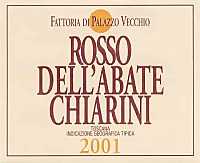
|
|
Rosso dell'Abate Chiarini 2001 |
|
| Fattoria di Palazzo Vecchio (Italy) | |
| Grapes: Sangiovese (70%), Merlot (30%) | |
| Price: € 11.00 | Score: |
| The wine shows a brilliant ruby red color and nuances of garnet red, little transparency. The nose reveals intense, clean, pleasing, refined and elegant aromas that start with hints of black cherry and violet followed by aromas of blueberry, blackberry, plum, vanilla, licorice, carob, mace and menthol. In the mouth has good correspondence to the nose, a slightly tannic attack and pleasing crispness, however balanced, full body, intense flavors, good tannins. The finish is persistent with flavors of plum and black cherry. This wine ages for 24 months in cask followed by 10 months of aging in bottle. | |
| Food Match: Braised and stewed meat, Game, Roasted meat, Hard cheese | |
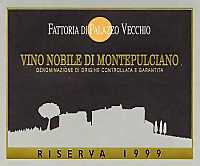
|
|
Vino Nobile di Montepulciano Riserva 1999 |
|
| Fattoria di Palazzo Vecchio (Italy) | |
| Grapes: Prugnolo Gentile (90%), Canaiolo Nero (10%) | |
| Price: € 18.00 | Score: |
| This Nobile shows a brilliant ruby red color and nuances of garnet red, little transparency. The nose reveals intense, clean, pleasing, refined and elegant aromas that start with hints of blackberry jam and raspberry jam followed by aromas of black cherry jam, plum jam, dried violet, licorice, tobacco, vanilla, carob and cinnamon. In the mouth has good correspondence to the nose, a slightly tannic attack and however balanced by alcohol, full body, intense flavors, good tannins. The finish is persistent with flavors of black cherry jam and raspberry jam. A well made wine. This reserve of Nobile di Montepulciano ages for 24 months in cask followed by 10 months of aging in bottle. | |
| Food Match: Braised and stewed meat, Roasted meat, Game, Hard cheese | |
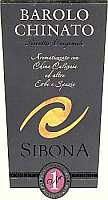
|
|
Barolo Chinato |
|
| Sibona (Italy) | |
| Grapes: Nebbiolo | |
| Price: € 20.00 - 50cl | Score: |
| This wine shows a pale garnet red color and nuances of brick red, moderate transparency. The nose denotes intense, clean, pleasing and refined aromas which start with hints of cinchona and plum jam followed by aromas of cinnamon, gentian, rhubarb, star anise and black pepper. In the mouth has good correspondence to the nose, a sweet and slightly tannic attack, however balanced, full body, intense flavors, agreeable. The finish is persistent with flavors of cinchona, gentian and rhubarb. This Barolo is aromatized with cinchona, aromatic herbs and spices. | |
| Food Match: Chocolate, Dried fruit tarts, Strudel | |
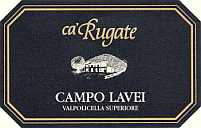
|
|
Valpolicella Superiore Campo Lavei 2002 |
|
| Ca' Rugate (Italy) | |
| Grapes: Corvina (40%), Rondinella (30%), Corvinone (30%) | |
| Price: € 13.30 | Score: |
| The wine shows a brilliant ruby red color and nuances of garnet red, moderate transparency. The nose reveals intense, clean, pleasing and refined aromas which start with hints of black cherry, blackberry and plum followed by aromas of violet, vanilla, tobacco, licorice, cinnamon and hints of menthol. In the mouth has good correspondence to the nose, a slightly tannic attack and however balanced by alcohol, good body, intense flavors, good tannins, agreeable. The finish is persistent with flavors of plum and black cherry. A well made wine. This Valpolicella ages in cask for 8-10 months. | |
| Food Match: Broiled meat and barbecue, Roasted meat, Braised and stewed meat, Hard cheese | |
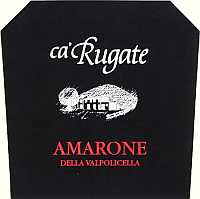
|
|
Amarone della Valpolicella 2001 |
|
| Ca' Rugate (Italy) | |
| Grapes: Corvina (40%), Rondinella (30%), Corvinone (30%) | |
| Price: € 37.80 | Score: |
| This Amarone shows an intense ruby red color and nuances of garnet red, little transparency. The nose reveals intense, clean, pleasing, refined and elegant aromas which start with hints of blackberry and black cherry followed by aromas of raspberry, plum, black currant, blueberry, dried violet, licorice, vanilla, enamel, chocolate, mace, pink pepper and hints of menthol. In the mouth has very good correspondence to the nose, a tannic attack and however well balanced by alcohol, full body, intense flavors, good tannins, agreeable. The finish is persistent with good flavors of blackberry, plum and black cherry. A well made wine. This Amarone ages in cask for about 25-30 months. | |
| Food Match: Game, Roasted meat, Braised and stewed meat, Hard cheese | |
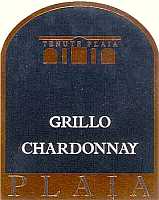
|
|
Plaia Grillo - Chardonnay 2003 |
|
| Plaia (Italy) | |
| Grapes: Grillo (70%), Chardonnay (30%) | |
| Price: € 10.00 | Score: |
| This wine shows an intense straw yellow color and nuances of straw yellow, very transparent. The nose reveals intense, clean, pleasing and refined aromas which start with hints of pineapple, pear and apple followed by aromas of hawthorn, broom, banana, peach and plum. In the mouth has good correspondence to the nose, a crisp attack and however balanced by alcohol, good body, intense flavors. The finish is persistent with flavors of plum, apple and pear. | |
| Food Match: Broiled fish, Roasted fish, Pasta and risotto with fish | |
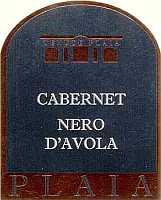
|
|
Plaia Cabernet - Nero d'Avola 2002 |
|
| Plaia (Italy) | |
| Grapes: Cabernet Sauvignon (50%), Nero d'Avola (30%), Syrah (20%) | |
| Price: € 13.00 | Score: |
| This wine shows an intense ruby red color and nuances of ruby red, little transparency. The nose reveals intense, clean and pleasing aromas which start with hints of blackberry and plum jam followed by aromas of black cherry, bell pepper, violet, licorice and carob. In the mouth has good correspondence to the nose, a slightly tannic attack and however balanced, good body, intense flavors. The finish is persistent with flavors of blackberry and black cherry. This wine ages in barrique. | |
| Food Match: Roasted meat, Braised and stewed meat, Hard cheese | |
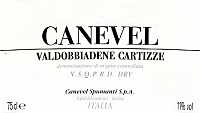
|
|
Prosecco di Valdobbiadene Dry Superiore di Cartizze 2003 |
|
| Canevel (Italy) | |
| Grapes: Prosecco | |
| Price: € 13.30 | Score: |
| This Prosecco shows a brilliant greenish yellow color and greenish yellow nuances, very transparent, fine and persistent perlage. The nose reveals clean and pleasing aromas that start with hints of peach and acacia followed by aromas of hawthorn, broom, wistaria, apple, pear and hints of litchi. In the mouth has good correspondence to the nose, an effervescent and crisp attack with slight and pleasing sweetness, however balanced, delicate, intense flavors, agreeable. The finish is persistent with flavors of pear, apple and peach. This Prosecco Cartizze is produced with the Martinotti method. | |
| Food Match: Dairy products, Semifreddo, Cream desserts | |

|
|
Prosecco di Valdobbiadene Extra Dry Il Millesimato 2003 |
|
| Canevel (Italy) | |
| Grapes: Prosecco | |
| Price: € 9.20 | Score: |
| This Prosecco shows a brilliant greenish yellow color and nuances of greenish yellow, very transparent, fine and persistent perlage. The nose reveals intense, clean, pleasing and refined aromas which start with hints of pear, apple and yeast followed by aromas of hawthorn, bread crust, almond, peach and pineapple. In the mouth has good correspondence to the nose, an effervescent and crisp attack, however balanced, good body, intense flavors, agreeable. The finish is persistent with flavors of peach, pear and apple. This Prosecco is produced with the Martinotti method. | |
| Food Match: Dairy products, Pasta and risotto with fish and crustaceans, Broiled crustaceans | |
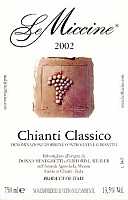
|
|
Chianti Classico 2002 |
|
| Le Miccine (Italy) | |
| Grapes: Sangiovese (95%), Malvasia Nera, Canaiolo Nero (5%) | |
| Price: € 13.00 | Score: |
| The wine shows an intense ruby red color and nuances of ruby red, moderate transparency. The nose denotes intense, clean and pleasing aromas that start with hints of black cherry and plum followed by aromas of blueberry, violet, vanilla, licorice, tobacco and carob. In the mouth has good correspondence to the nose, a slightly tannic attack and however balanced by alcohol, good body, intense flavors, good tannins. The finish is persistent with flavors of black cherry and plum. This Chianti ages for 9 months in cask followed by at least 6 months of aging in bottle. | |
| Food Match: Sauteed meat, Broiled meat and barbecue, Roasted meat, Stewed meat with mushrooms | |
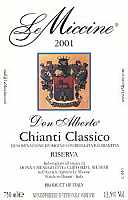
|
|
Chianti Classico Riserva Don Alberto 2001 |
|
| Le Miccine (Italy) | |
| Grapes: Sangiovese | |
| Price: € 21.00 | Score: |
| This Chianti shows a brilliant ruby red color and nuances of ruby red, moderate transparency. The nose denotes intense, clean, pleasing and refined aromas which start with hints of black cherry and raspberry followed by aromas of blueberry, plum, cyclamen, dried violet, vanilla and licorice. In the mouth has good correspondence to the nose, a slightly tannic attack and pleasing crispness, however balanced by alcohol, full body, intense flavors, good tannins. The finish is persistent with flavors of black cherry, raspberry and plum. This Chianti ages for 21 months in cask followed by 12 months of aging in bottle. | |
| Food Match: Roasted meat, Braised and stewed meat, Broiled meat and barbecue, Hard cheese | |
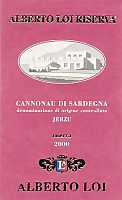
|
|
Cannonau di Sardegna Jerzu Riserva Alberto Loi 2000 |
|
| Alberto Loi (Italy) | |
| Grapes: Cannonau | |
| Price: € 10.80 | Score: |
| The wine shows a brilliant ruby red color and nuances of garnet red, moderate transparency. The nose reveals intense, clean, pleasing and refined aromas which start with hints of black cherry and plum followed by aromas of violet, vanilla, blueberry, licorice, cinnamon, chocolate and hints of menthol. In the mouth has good correspondence to the nose, a slightly tannic attack and however balanced by alcohol, good body, intense flavors, good tannins. The finish is persistent with flavors of black cherry and plum. This Cannonau ages for 12-14 months in cask, 4 months in barrique and 8 months in bottle. | |
| Food Match: Roasted meat, Broiled meat and barbecue, Stewed meat, Hard cheese | |
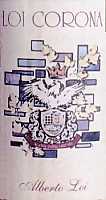
|
|
Loi Corona 2000 |
|
| Alberto Loi (Italy) | |
| Grapes: Cannonau (70%) | |
| Price: € 22.80 | Score: |
| This wine shows a brilliant ruby red color and nuances of garnet red, moderate transparency. The nose has good personality with intense, clean, pleasing, refined and elegant aromas which start with hints of cherry and plum jam followed by aromas of strawberry jam, raspberry jam, blueberry jam, vanilla, dried violet, licorice, tobacco, carob and cinnamon. In the mouth has good correspondence to the nose, a slightly tannic attack and pleasing crispness, full body, intense flavors, good tannins, agreeable. The finish is persistent with flavors of raspberry jam, strawberry jam and cherry. A well made wine. Loi Corona ages in barrique for 18-20 months and for 12 months in bottle. | |
| Food Match: Braised and stewed meat, Roasted meat, Game, Hard cheese | |
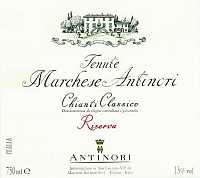
|
|
Chianti Classico Riserva Tenute Marchese Antinori 2000 |
|
| Antinori (Italy) | |
| Grapes: Sangiovese (90%), Cabernet Sauvignon (10%) | |
| Price: n.a. | Score: |
| This Chianti shows an intense ruby red color and nuances of garnet red, little transparency. The nose denotes intense, clean, pleasing and refined aromas that start with hints of plum and black cherry jam followed by aromas of blueberry jam, pomegranate, dried violet, vanilla, licorice, tobacco, carob and pink pepper. In the mouth has good correspondence to the nose, a slightly tannic attack and however well balanced by alcohol, full body, intense flavors, good tannins, agreeable. The finish is persistent with flavors of plum and black cherry jam. This Chianti ages for 14 months in barrique followed by at least 12 months of aging in bottle. | |
| Food Match: Braised and stewed meat with mushrooms, Roasted meat, Game, Hard cheese | |
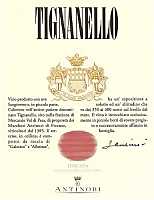
|
|
Tignanello 2001 |
|
| Antinori (Italy) | |
| Grapes: Sangiovese (85%), Cabernet Sauvignon (10%), Cabernet Franc (5%) | |
| Price: n.a. | Score: |
| This wine shows an intense ruby red color and nuances of garnet red, little transparency. The nose reveals intense, clean, pleasing, refined and elegant aromas which start with hints of black cherry, plum and blueberry followed by aromas of blackberry, vanilla, dried violet, licorice, tobacco, pink pepper, cocoa, cinnamon, eucalyptus and bell pepper. In the mouth has very good correspondence to the nose, a tannic attack and however well balance by alcohol, full body, intense flavors, good tannins, agreeable. The finish is very persistent with long flavors of plum, black cherry and blueberry. A very well made wine. Tignanello ages for 14 months in barrique followed by 12 months of aging in bottle. | |
| Food Match: Game, Roasted meat, Stewed and braised meat, Hard cheese | |
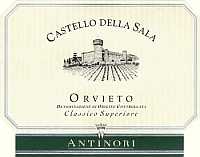
|
|
Orvieto Classico Superiore 2003 |
|
| Castello della Sala (Italy) | |
| Grapes: Procanico (40%), Grechetto (27%), Verdello (15%), Drupeggio, Malvasia (3%), Chardonnay (15%) | |
| Price: n.a. | Score: |
| The wine shows a brilliant straw yellow color and nuances of greenish yellow, very transparent. The nose reveals intense, clean, pleasing and refined aromas which start with hints of broom, pear and plum followed by aromas of pineapple, litchi, apple, grapefruit and hawthorn. In the mouth has good correspondence to the nose, a crisp attack and however balanced by alcohol, good body, intense flavors, agreeable. The finish is persistent with flavors of apple, plum and pineapple. This wine ages in steel tanks. | |
| Food Match: Fried fish, Sauteed fish, Pasta and risotto with fish and crustaceans | |
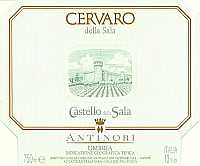
|
|
Cervaro della Sala 2002 |
|
| Castello della Sala (Italy) | |
| Grapes: Chardonnay (80%), Grechetto (20%) | |
| Price: n.a. | Score: |
| This wine shows a brilliant golden yellow color and nuances of golden yellow, very transparent. The nose reveals personality with intense, clean, pleasing, refined and elegant aromas which start with hints of quince, banana, hawthorn and toasted wood followed by aromas of acacia, pineapple, honey, mineral, hazelnut, pear, grapefruit and coffee. In the mouth has very good correspondence to the nose, a crisp attack and however well balanced by alcohol, good body, intense flavors, agreeable. The finish is very persistent with long flavors of quince, banana, pineapple and grapefruit. A very well made white wine. Cervaro della Sala ferments and ages in barrique for 5 months followed by 10 months of aging in bottle. | |
| Food Match: Roasted fish, Stuffed pasta, Roasted white meat, Stewed fish | |
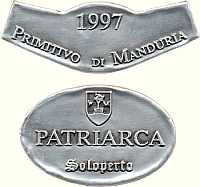
|
|
Primitivo di Manduria Patriarca 1997 |
|
| Soloperto (Italy) | |
| Grapes: Primitivo | |
| Price: € 20.50 | Score: |
| The wine shows an intense ruby red color and nuances of garnet red, little transparency. The nose reveals intense, clean, pleasing and refined aromas which start with hints of plum jam, blackberry jam and black cherry jam followed by aromas of carob, blackberry jam, licorice, vanilla and hints of star anise. In the mouth has good correspondence to the nose, a slightly tannic attack and however balanced by alcohol, full body, intense flavors, good tannins. The finish is persistent with flavors of plum jam and blackberry jam. This Primitivo ages for 9 months in barrique and for at least 2 years in cask. | |
| Food Match: Stewed and braised meat, Roasted meat, Game, Hard cheese | |

|
|
Primitivo di Manduria Rubinum 1998 |
|
| Soloperto (Italy) | |
| Grapes: Primitivo | |
| Price: € 7.50 | Score: |
| This Primitivo shows an intense ruby red color and nuances of garnet red, little transparency. The nose reveals intense, clean, pleasing and refined aromas which start with hints of plum jam, black cherry jam and blackberry jam followed by aromas of dried violet, vanilla, licorice, tobacco, cocoa, cinnamon and cinchona. In the mouth has good correspondence to the nose, a slightly tannic attack with good smoothness and pleasing hints of sweetness, however balanced by alcohol, full body, intense flavors, good tannins, agreeable. The finish is persistent with flavors of plum jam and blackberry jam. A well made wine. This Primitivo ages in cask for at least 2 years. | |
| Food Match: Stewed and braised meat, Roasted meat, Hard cheese | |
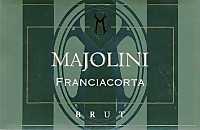
|
|
Franciacorta Brut |
|
| Majolini (Italy) | |
| Grapes: Chardonnay, Pinot Noir | |
| Price: € 15.60 | Score: |
| This wine shows an intense straw yellow color and nuances of straw yellow, very transparent, good effervescence, fine and persistent perlage. The nose reveals intense, clean, pleasing and refined aromas which start with hints of plum, praline and banana followed by aromas of acacia, hawthorn, kiwi, bread crust, apple, hazelnut and grapefruit. In the mouth has good correspondence to the nose, a crisp and effervescent attack, however balanced, good body, intense flavors, agreeable. The finish is persistent with flavors of kiwi and apple. The Chardonnay used for the base wine ages in barrique. This Franciacorta ages on its lees for at least 24 months. | |
| Food Match: Fried fish, Pasta and risotto with fish and crustaceans, Broiled fish and crustaceans | |
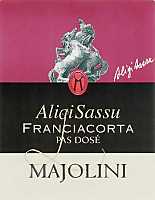
|
|
Franciacorta Pas Dosé Aligi Sassu 1999 |
|
| Majolini (Italy) | |
| Grapes: Chardonnay | |
| Price: € 20.30 | Score: |
| This Franciacorta shows a brilliant straw yellow color and nuances of straw yellow, very transparent, good effervescence, fine and persistent perlage. The nose reveals intense, clean, pleasing and refined aromas which start with hints of plum and honey followed by aromas of banana, hawthorn, yeast, marzipan, bread crust, pear and apple. In the mouth has good correspondence to the nose, an effervescent and crisp attack, however well balanced, good body, intense flavors, agreeable. The finish is persistent with flavors of apple, pear and plum. A well made wine. This Franciacorta ages in the bottle on its lees for at least 30 months. | |
| Food Match: Pasta and risotto with fish and crustaceans, Broiled fish and crustaceans, Fish appetizers | |
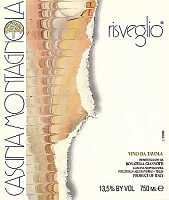
|
|
Risveglio 2000 |
|
| Cascina Montagnola (Italy) | |
| Grapes: Chardonnay | |
| Price: € 18.00 | Score: |
| This wine shows a pale golden yellow color and nuances of straw yellow, very transparent. The nose reveals good personality with intense, clean, pleasing and refined aromas that start with hints of hazelnut, passion fruit and vanilla followed by aromas of praline, grapefruit, banana, acacia, hawthorn, apple and plum. In the mouth has good correspondence to the nose, a crisp attack and however balanced, good body, intense flavors, agreeable. The finish is persistent with flavors of plum, banana and passion fruit. A well made wine. Risveglio ages for 6 months in cask. | |
| Food Match: Roasted fish, Stewed fish, Roasted white meat, Stuffed pasta | |
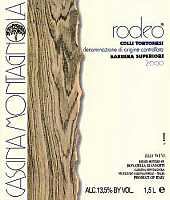
|
|
Colli Tortonesi Barbera Superiore Rodeo 2000 |
|
| Cascina Montagnola (Italy) | |
| Grapes: Barbera | |
| Price: € 16.00 | Score: |
| This Barbera shows a brilliant ruby red color and nuances of garnet red, little transparency. The nose reveals good personality with intense, clean, pleasing and refined aromas which start with hints of plum, pomegranate and blackberry followed by aromas of vanilla, violet, cyclamen, blueberry, black cherry, licorice, tobacco, cocoa and eucalyptus. In the mouth has good correspondence to the nose, a slightly tannic attack and pleasing crispness, however well balanced by alcohol, full body, intense flavors, good tannins. The finish is persistent with flavors of pomegranate, black cherry, plum and blackberry. A well made wine. This Barbera ages for 12-14 months in cask. | |
| Food Match: Game, Roasted meat, Stewed and braised meat with mushrooms, Hard cheese | |
TorreventoOriented to the production and revaluation of Castel del Monte wines, Torrevento is also the productive headquarter of I Pastini winery, whose goals also include the revaluation of the ancient and typical grapes of Apulia |
|
Among the most famous monuments of the Apulia region - as well as of the world - there is the suggestive “Castel del Monte”, the renowned building with octagonal base which Frederich II of Swabia built in 1220 as his hunting lodge and today recognized as a worldwide heritage from UNESCO. The celebrity and the historical importance of this beautiful building is such that its image has been used in the back side of the one cent Euro coin issued by the Italian Republic. In Apulia, Castel del Monte does not only mean the suggestive building, in the world of enology is also synonym of wine and - in particular - it is an area of Denomination of Controlled Origin (DOC) of the region representing the “heel” of Italy. The octagonal shape of the famous monument was also used for the trademark of Torrevento winery located at Corato, in the province of Bari and not distant from the suggestive building.
In the eighteenth century, not far from the renowned monument - exactly at “Torrevento” place - was built one of the most beautiful monasteries in stone of all North-Western Murgia. In 1949, when the monastery was not used anymore as a place of cult, it was purchased, together with the estate, by brothers Liantonio. In this place they established the family wine business and later it was called like the place in which is located Torrevento winery. The thick walls of the monastery - with a thickness of 1.5 meters (about 5 feet) - host the large cellar built in the rock of the ancient undergrounds of the monastery: here, at about 8 meters deep (26 feet) and in optimal conditions, are being aged Torrevento's wines. The building underwent important restoration works in order to allow a proper expansion as well as the introduction of new technologies, according to a precise plan of development and in the full respect of the original structure, as well as of the territory of Murgia and of the views of Castel del Monte area in which it is located. Recently at Torrevento they restored the ancient stable therefore transforming it into a welcoming wine tasting hall with stone walls, used to welcome tourists, clients and wine lovers. Torrevento is particularly involved in the production of wines with typical grapes of the Apulian enology. The mainly hilly nature of the Bari's northern Murgia - area in which are located the vineyards of the winery - as well as a favorable microclimate, make the ideal conditions for the cultivation of autochthonous white berried grapes, such as Bombino Bianco and Pampanuto, as well as the red berried ones, such as Bombino Nero and Nero di Troia. Today Torrevento winery owns an estate with a total acreage of 150 hectares (370 acres) all destined to viticulture and located in many areas of the territory. In “contrada Pedale” is being cultivated Nero di Troia grape - used for the production of “Castel del Monte Rosso Vigna Pedale” wine - as well as Bombino Nero and Montepulciano varieties destined to the production of Castel del Monte Rosato. In the vineyards near “contrada Pedale” are being cultivated the grapes used for the production of Kebir.
In the vineyards located in the Andria area are being cultivated the varieties Nero di Troia, Aglianico, Bombino Bianco and Pampanuto. In the vineyards of Torrevento are also cultivated the grapes Cabernet Franc, Cabernet Sauvignon and Moscato Reale. Besides the wines of Castel del Monte area, Torrevento also makes other products such as Salice Salentino Rosso, made with Negroamaro and Malvasia Nera grapes, and purchases Verdeca grapes - cultivated according to organic agriculture principles - for the production of Puglia Bianco Proemio wine, Nero di Troia and Montepulciano - still from organic agriculture - for Castel del Monte Rosso Proemio wine. Torrevento also distributes the wines of I Pàstini winery - of which is also the productive headquarter - run by Carparelli brothers. I Pàstini winery owns vineyards for about an acreage of 10 hectares (about 25 acres) in which are being cultivated Verdeca, Bianco d'Alessano and Fiano Minutolo grapes used for the production of Locorotondo white wine. In some rented vineyards, Carparelli brothers cultivate Primitivo grape - with which is produced the red Primitivo del Tarantino - Cabernet Franc, Cabernet Sauvignon and Montepulciano used for the red wine Murgia Rosso. The I Pàstini winery also produces - in limited quantities - the sweet red “Elogio alla Lentezza” with Aleatico grape. The winery of Carparelli brothers is also involved since many years to the revaluation of ancient grapes of the area - a work started with a scrupulous selection and began in 2000 - by searching the territory in the communes of Locorotondo, Martina Franca, Alberobello and Cisternino for Fiano Minutolo grape sprouts. These sprouts have been subsequently grafted in the vineyards of the property in order to resume their cultivation and in order to make wine. From the result of this selection and of the revaluation of this particular variety, I Pàstini produces “Vigna Rampone”, an interesting wine with good personality in which are found intense aromatic qualities of grape and peach. Today Torrevento winery is present - besides the Italian market - also in all the countries of the European Community, United States of America, Canada, Australia, Hong Kong and Japan. Dr. Francesco Liantonio - chairman of Torrevento - is in charge for the management, whereas the technical aspects of the winery are run by wine maker Pasquale Carparelli. The production of Torrevento is wide and interesting, with wines of good quality in respect of local enological traditions. Particularly interesting is the last wine created by the winery from Corato - Kebir - produced with Nero di Troia and Cabernet Sauvignon grapes in equal parts and aged for 12 months in barrique. Also good is Castel del Monte Vigna Pedale, agreeable and well made, as well as Moscato di Trani “Dulcis in Fundo”, pleasing with a balanced sweetness. Among wines produced by I Pàstini winery are worth of note Fiano Minutolo Vigna Rampone and Locorotondo Bianco.
|
||||||||||||||||||||
|
Score legend Prices are to be considered as indicative. Prices may vary according to the country or the shop where wines are bought |
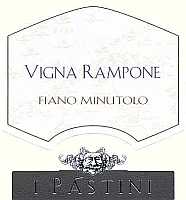
|
|
Vigna Rampone I Pastini 2003 |
|
| Torrevento (Italy) | |
| Grapes: Fiano Minutolo | |
| Price: € 8.75 | Score: |
| The wine shows a brilliant straw yellow color and nuances of greenish yellow, very transparent. The nose reveals good personality with intense, clean, pleasing and refined aromas which start with hints of grape and peach followed by aromas of acacia, broom, litchi, passion fruit, pear, white rose and hints of sage. In the mouth has good correspondence to the nose, a crisp attack and however balanced by alcohol, good body, intense flavors, agreeable. The finish is persistent with flavors of grape, pear and peach. | |
| Food Match: Pasta and risotto with fish and crustaceans, Broiled crustaceans, Sauteed fish | |
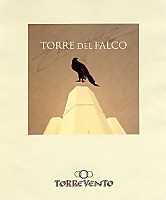
|
|
Torre del Falco 2001 |
|
| Torrevento (Italy) | |
| Grapes: Cabernet Sauvignon (80%), Nero di Troia (20%) | |
| Price: € 5.20 | Score: |
| The wine shows a brilliant ruby red color and nuances of ruby red, little transparency. The nose denotes intense, clean, pleasing and refined aromas which start with hints of blackberry, violet and black cherry followed by aromas of blueberry, plum, carob and licorice. In the mouth has good correspondence to the nose, a slightly tannic attack and however balanced by alcohol, good body, intense flavors, good tannins. The finish is persistent with flavors of plum, black cherry and blackberry. This wine ages in steel tanks. | |
| Food Match: Broiled meat and barbecue, Stewed meat, Hard cheese | |
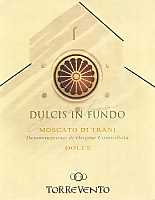
|
|
Moscato di Trani Dulcis in Fundo 2003 |
|
| Torrevento (Italy) | |
| Grapes: Moscato Reale | |
| Price: € 7.20 - 500ml | Score: |
| This wine shows a brilliant golden yellow color and nuances of straw yellow, very transparent. The nose reveals intense, clean, pleasing and refined aromas which start with hints of grape and peach followed by aromas of banana, candied fruit, dried fig, broom, chamomile, litchi and honey. In the mouth has good correspondence to the nose, a slightly crisp attack and pleasing sweetness, however balanced by alcohol, good body, intense flavors, agreeable. The finish is persistent with flavors of grape, peach and litchi. This wine is produced with late harvested grapes. | |
| Food Match: Cream desserts, Fruit tarts | |
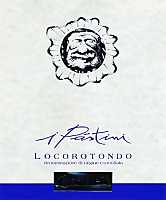
|
|
Locorotondo I Pastini 2003 |
|
| Torrevento (Italy) | |
| Grapes: Verdeca, Bianco d'Alessano, Fiano Minutolo | |
| Price: € 4.40 | Score: |
| This wine shows a brilliant golden yellow color and nuances of straw yellow, very transparent. The nose reveals good personality with intense, clean, pleasing and refined aromas that start with hints of ripe pear and banana followed by aromas of pineapple, hawthorn, chamomile, broom, quince and peach. In the mouth has good correspondence to the nose, a crisp attack and however balanced by alcohol, good body, intense flavors, agreeable. The finish is persistent with flavors of peach, pear and pineapple. | |
| Food Match: Stuffed pasta with fish and mushrooms, Fish soups, Sauteed fish | |
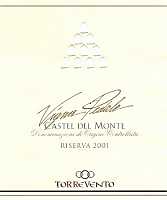
|
|
Castel del Monte Rosso Riserva Pedale 2001 |
|
| Torrevento (Italy) | |
| Grapes: Nero di Troia | |
| Price: € 6.00 | Score: |
| This wine shows an intense ruby red color and nuances of ruby red, little transparency. The nose reveals intense, clean and pleasing aromas that start with hints of raspberry and black cherry followed by aromas of blueberry, plum, pomegranate, strawberry and cyclamen. In the mouth has good correspondence to the nose, a slightly tannic attack and however balanced by alcohol, good body, intense flavors, good tannins, agreeable. The finish is persistent with flavors of black cherry, plum and blueberry. This wine ages in steel tanks. | |
| Food Match: Broiled meat and barbecue, Roasted meat, Stewed meat, Hard cheese | |
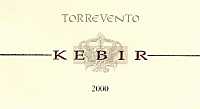
|
|
Kebir 2001 |
|
| Torrevento (Italy) | |
| Grapes: Nero di Troia (50%), Cabernet Sauvignon (50%) | |
| Price: € 10.80 | Score: |
| This wine shows a deep ruby red color and nuances of garnet red, impenetrable to light. The nose reveals intense, clean, pleasing and refined aromas which start with hints of black cherry jam, blackberry jam and plum jam followed by aromas of blueberry, dried violet, vanilla, carob, cinnamon, licorice and tobacco. In the mouth has good correspondence to the nose, a tannic attack and pleasing crispness, however well balanced by alcohol, full body, intense flavors, good tannins. The finish is persistent with flavors of plum jam and blackberry jam. A well made wine. Kebir ages for 12 months in barrique. | |
| Food Match: Braised and stewed meat, Game, Roasted meat, Hard cheese | |
| Torrevento - Località Castel del Monte, S.S. 170 Km 28 - 70033 Corato, Bari (Italy) - Tel. +39 80 8980923 Fax. +39 80 8980944 - Winemaker: Pasquale Carparelli - Established: 1989 - Production: 2.000.000 bottles - E-Mail: torrevento@libero.it - WEB: www.torrevento.it |
Cellar Journal |
|
This section is reserved to wine producers who want to publish news and information about their business, to announce new products or just for communicating to its customers information and promotions about their products and activity. Send news to be published at our e-mail address.
|
News |
|
In this section will be published news and information about events concerning the world of wine and food. Whoever is interested in publishing this kind of information can send us a mail at our address.
|
Sensorial Analysis of FoodEnogastronomical matching is the happy marriage between wine and food, an art which is usually considered difficult but in reality it requires just a little of good taste, curiosity and initiative |
|
It is said that the most binding test for a wine it is the matching with a food, of course not all foods, but certainly the ones that - at least in theory - are complementary to it according to an organoleptic point of view. The choice of a wine to be matched to a food is usually considered hard by most of the lovers of the beverage of Bacchus as well as by the ones of good cooking, it is often believed the enogastronomical matching is a sort of alchemy that only few elected can put into practice. It is good to remember, whenever you talk about enogastronomical matching, these two fundamental presuppositions. First of all, the matching defined according technical principles has the goal of formulating a pairing objectively agreeable and, secondly, the subjectivity of a matching cannot be replaced by a technical solution anyway. This does mean that in case a person likes matching a very acid wine to a salad seasoned with lots of vinegar - a condition which is always discouraged according to technical principles - no rule or imposition is neither licit nor opportune. For this reason when you talk about enogastronomical matching - an art whose goal is the gratification of the senses of an individual by means of the complementarity or contrast of wine and food - it is always opportune to remember it is a suggestion and never an absolute rule: in other words, conditional is always a must. Moreover it is good to remember the enogastronomical matching can be done according to principles having no technical basis, such as traditional, cultural, seasonal, romantic, poetic and - in particular - personal factors. This is why the famous saying “fish always goes with white wine” - a very common saying about enogastronomy - besides being denied by obvious technical principles, it could also be little agreed by many if not at all. The secret of success in enogastronomical matching is essentially represented by curiosity and initiative in discovering new sensations and new tastes. In case only the strict rules of matching would be considered, no one would have the idea - and the curiosity - of matching a sweet wine to a salty and proteinic food such as meat or cheese. The traditions of some places in which are being produced renowned and historical sweet wines, teaches that even these wines can be well matched to roasted meat, even very elaborated. An example for all is Sagrantino di Montefalco Passito - sweet and pretty tannic - traditionally matched to hard pecorino cheese and, during the Eastern lunch, with the “robust” roasted lamb prepared according the Umbrian tradition. Moreover are renowned - as well as tasty and gratifying - the many matching of sweet wines with hard and piquant cheese. However tradition - even though in this specific case would be better to talk about “common belief” - does not always suggest pleasing or well made matchings, at least according a technical point of view. If we talk, for example, about oysters or caviar and we ask about the name of a wine to be matched, the most probable answer would be Champagne or however a sparkling wine. Indeed - according to a technical point of view - this is not a right matching. The reasons of the celebrity of this matching - just like many others - is connected to the gratification derived by joining two luxury and expensive products; a principle which does not satisfy any organoleptic sensation and greatly enhances the psychological conditioning.
|
|
It is undeniable that food evokes in men such different emotions and that each person has a relationship to it in an absolutely personal way. For humans food is not only an element for survival, of course not in poor conditions when even a small chunk of bread represents the border between life and death and it is cause of violent competitions. It is enough to observe the gastronomical traditions of every culture and society in order to understand food goes beyond the “simple” act of eating. Cooking certainly is one of the many human expressions in which it is possible to appreciate the inventive on man - in this case in positive terms - where intuition, fantasy and intelligence are joined together in order to create something which goes beyond the need of feeding and to ensure survival. Colors, aromas, flavors, tastes, contrasts and harmonies are just some of the elements found in food and that play a fundamental role in pleasure - strong and deep - going beyond the need of “eating”. These elements - that is the capacity of recognizing and appreciating these “ingredients” - make the difference between eating, tasting, contemplating, appreciating and gorging oneself with food.
Watching a person eating is an useful exercise in order to understand his or her relationship with food. There are persons who simply take the food to their mouth without considering or evaluating other aspects. Others watch, smell and sample it and then eat it, while trying to understand every aspect of its composition, from ingredients to the cooking technique, from the way it was presented to the sensation it can give. It is undeniable our modern life style - frantic, not very natural and of which all of us are responsible - has contributed to a progressive distraction towards certain sensations and emotions, not only the ones connected to food, by making us pretty frivolous and superficial beings, most of the times attracted by the illusion of appearance. Our ancestors who lived some centuries ago, were probably more attentive to the quality of food and they probably watched, smelt and sampled it before eating, in other words they made sure that - first of all - it was not noxious. This is a habit we “modern men” have lost probably because of the relative certainty offered by the food industry, accustomed to the idea that we could hardly find a spoilt or noxious food. Whoever loves nice food does not consider eating a mere act of greed: it is undeniable that being greed for food gives satisfaction, however it is true that the real gourmet is the one who can appreciate every quality of food, very different from the one who eats compulsively or absent-mindedly. If we would try to be more critic and attentive to what we eat, many foods of disputable quality - but well supported by specific economic interests - would not probably meet the interest of people who would be more caring to what they eat instead. To tell the truth, it is good to remember that the use of certain ingredients as well as the use of specific cooking techniques contribute to hide some faults and defects of certain foods and they can even make them disappear. The more one it is attentive and critic towards he or she eats, the more it will be easy to discover certain tricks and to appreciate food better. This capacity is not reserved to few persons only: it is enough to pay more attention to the food you find in your dish while trying to understand it before eating. After all everyone has sensorial capacities allowing the analysis of food - of course as well as of wine, being food itself - the important thing is to remember to have them and to make a good use of them. Formulating an enogastronomical matching means - first of all - to have the capacity and will to know every organoleptic aspect of food and of wine: only after having understood these factors it will possible to define a matching in an objectively agreeable way. The most dangerous enemies in this regard certainly are distraction and superficiality; the best allies are experience, knowledge of cooking, of ingredients and cooking techniques. After all, how can you express an opinion or a judgment about what you do not know - or even worse - of what you do not want to know? Organoleptic evaluation of food - as well as of wine - requires concentration and commitment: attitudes which are not always easy to put in practice, in particular for the ones who are accustomed for a long time to not pay attention and concentration on their senses involved in eating or drinking. It is not a hard or impossible job: every person - saved the case of specific pathologies - has senses which continuously send information to the brain: it is enough to pay more attention and to try to listen even to the most weak signals that our sensorial system is capable of detecting.
|
||||||||
|
In most of the cases, the evaluation of a food simply means tasting it with the mouth, perceiving its taste and swallowing, nothing else. This operation, in its essentiality, however requires the involvement of three sensorial qualities: taste, smell and touch. The involvement of taste - in the sense or the recognition of fundamental flavors - is probably obvious to many, maybe it is less obvious the involvement of smell - but it is good to remember that without smell there would not be taste - whereas touch allows the recognition of consistence and physical qualities of a food. In other words, if the combination taste-smell allows us to recognize an apple from a cucumber, it is touch which allows us the recognition of a liquid from a solid, a cold food from a hot food. Evaluating a food means analyzing it with attention, not only with the above mentioned sensorial qualities, but also by using the senses of sight and hearing. Sight allows the comprehension of the appearance - a fundamental factor for the psychological gratification associated to food - whereas hearing provides other information about the freshness and quality of ingredients. An example could be the “sound” produced by biting a fresh or faded carrot, as well as the noise produced by snapping a bar of good chocolate. The appearance of a food and the way it is presented, represent the first approach for the taster. Appearance - besides positively or negatively preparing the taster - offers important information about its preparation and about the ingredients used. It is undeniable that a food having a pretty bad aspect, negatively influences its pleasingness and this factor is well known by cooks, restaurateurs and food industries which, of course, try their very best in order to take advantage of the presentation of foods. The aesthetical aspect of a food is however important: it is a sign of hygiene and good cooking, however it is good to remember that most of the times the appearance is deceiving and what it is nice for the eyes could not be good for taste. Evaluate the aspect and the good presentability of food, but never stop to the superficial evaluation of this aspect only. The primary information that can be understood by appearance are the quality and the quantity of ingredients as well as the cooking technique and the preparation method. Also remember the way a food was prepared strongly influences its taste. For example it is enough to watch vegetables in order to understand whether the cooking was excessive with a subsequent loss or alteration of organoleptic qualities and nutrients. An aspect to which few persons pay attention during the tasting of a food is its smell. The aromas of a food - just like for wine - is a factor of fundamental importance in order to understand the quality and the quantity of ingredients, the agreeability and the cooking method, such as the use of aromatic herbs or spices. Moreover, thanks to smell it is possible to recognize some cooking faults, such as smells of burnt. The first smell evaluation will be done about the overall aromas of the food. Take the dish in which the food was served and raise it to your nose - or vice versa - and smell the aromas altogether by doing circular movements in order to perceive the aromas of the entire food. Smelling what you taste is of fundamental importance and it is good to remember that taste is a sensorial quality which is also expressed by means of aromas. In order to understand the importance of smell in the evaluation of taste, try to taste some types of foods blindfolded and with your nose closed: in most of the cases it will be impossible to recognize even the most simple and common foods. The next phase consists in evaluating a small part of food that will be introduced in the mouth. Take a small quantity of food with a fork and raise it to the level of the nose, therefore doing another olfactory evaluation: the aromatic qualities of food will have probably changed in regard to its overall impact. Put the food in your mouth and chew it, evaluate all the flavors as well as the overall impression of taste - that is the combination of primary flavors and smell - while trying to analyze, just like you would do for wine, the correspondence of taste analysis with aromas analysis. According to the most common theories about taste, the primary flavors are four - sweet, salty, sour and bitter - however it is good to remember that this theory, formulated more than one hundred years ago, was denied, or better completed, by some researches done in Japan in the beginning of 1900's and that only recently have been accepted in the western world. To the four fundamental tastes is to be added a fifth one - the so called umami - found in many foods and playing a fundamental role on their agreeability. Often and mistakenly associated to sodium glutamate, in reality umami is a more complex taste sensation, sometimes described as the taste of a sapid and tasty food similar to meat broth. Umami would deserve a more comprehensive discussion - which would go beyond the purpose of this preliminary introduction - however it is undeniable its presence is perceptible in the complexity of many foods, and many traditional sauces used in the western cooking - as well as pizza and Parmigiano Reggiano, as to give some examples - are particularly rich. The last analysis done on food is about harmony and balance. Just like for wine, even foods are considered according to the harmony of ingredients, where one exalts and completes the other without excessively prevailing. The quality of balance in foods is a characteristic found in aromas and in taste, last but not the least, in the aspect. For example, in case in a spicy food it is not possible to appreciate the aroma and the taste of the main ingredient, its harmony and its balance will be scarce, whereas in a food in which the presence of spices completes and allow the perception of the organoleptic qualities of the main ingredient, the harmony and balance will be high. At the end of this brief introduction, we would like to suggest you to pay more attention on food: we are certain you will enjoy better the experience of eating. Finally it is good to remember that eating is not tasting and that food is also a source of pleasure, not only of survival. In case it would be like that, every edible thing would suffice to this purpose.
|
||||
CocktailsAfter the end of World War Two, since the spreading of cocktails, this way of drinking has never been influenced by fashions and does not show any sign of decay, it is always alive and new |
|
The Italian dictionary of correct style reads: “cocktail is an Anglo-American term used to refer to the well known blend of many liquors with crushed ice which is drunk after having been shaken in a can called, in English, shaker”. The Merriam-Webster Dictionary of 1947 defines cocktail as a “short beverage of liquors blended with aromatic ingredients, or a beverage made of fresh fruit juices”. Ten years later the Modern American Dictionary defines it as a “beverage of gin, whisky or brandy blended with vermouth, fruit juices and other”. None of the above definitions fully describe it - a world continuously shaking - where the classic and modern live together, in which are being continuously invented new recipes and new ways of amazing, inviting and stimulating the ones who are always looking for something new.
|
|
The history of humanity and the one of alcohol, since the beginning of times, have come a very long way. Since man has discovered how to ferment sugar and musts, he began to appreciate alcohol, to drink it, straight or blended with aromatic and officinal herbs, always looking for miraculous elixirs capable of healing the many diseases of life. Romans, for example, used hydromeli - that is cooked wine blended with honey - as an aperitif. This custom slowly spread beyond the borders of the empire and reached Brittany where it is still known today. During the Middle Age, from Caterina de' Medici to Girolamo Savonarola, as to mention two illustrious figures, it began the exploration of the art of blending, the first mixtures made of liquors and extracts of herbs were created, having the most fanciful properties. Even viticulturists, monks and alchemists were involved in this practice. In “Vie de Paris Sous Louis XII”, Louis Batiffol wrote «when vinegar producers began to distillate brandy, they had the idea of selling cherries preserved in spirit and served in small glasses or cups. The brandy smoothened with sugar and fruit, was then called “eau clairette”. In the sixteenth century, instead of cherries, they began to use oranges, strawberries, black currants and other, therefore creating the first orange, strawberry and black currant waters. The trade or liquors remained free until Louis XIV who established the confraternity of Limonadiers (literally, lemonade makers), joining them to brandy distillers, it was 1676».
It is now accepted the origin of making modern cocktails is Anglo-Saxon: this theory is confirmed by the fact the most ancient name was “bitter sling”. In 1806 a magazine defined cocktail as “stimulating beverage, made of different alcoholic substances to which is added sugar, water and bitter”. Paolo Monelli wrote that when he arrived at New Orleans, he deserted the concert of Louis Armstrong in order to follow the advice of a barman: curious and impatient he went to 437 Royal Street where he found a small house in which was written “The cocktail is born”. It was the house and shop of Antoine Peychaud - a pharmacist follower of a local masonic lodge - and when one of the members entered the pharmacy, he used to welcome them with a beverage prepared according an ancient recipe of his original country, Santo Domingo. It was a mixture of marc, cognac, sugar and other spices. For the dosage of the ingredients and to serve the beverage, the good pharmacist used a cocquetier. The pharmacist's beverage of 437 Royal Street was so successful that all of his clients began asking for a “cocquetier”. It is believable that from the name “cocquetier”, the term was transformed into “cocktail”. The figure of the pharmacist is well suited to represent the father of a beverage whose preparation must be scrupulous and never be the result of chance or approximation. The cocktail rapidly spread all over the world, in the first place among the persons working in this area - in particular barmen - who know all the secrets of the blends and know how to use fantasy in order to create new combinations that always stimulate the curiosity of their clients. The world of the “blended drinks” traveled our planet from the most renowned bars of the world to fashion night clubs and international places. Every luxury place, bars, hotels and fashion restaurants, begins to serve cocktails with sophisticated names as well as extravagant and exotic. The equipment of barman gets enriched of new tools: the shaker and a long series of tools used to cut, squeeze, peel and filter. The history of cocktails is full of characteristic figures who strongly influenced their spreading, such as Ernest Hemingway, the writer who loved to go to bars and restaurants in company of illustrious friends from all over the world, excellent connoisseurs and lover of wine and of the world of cocktails. Hemingway used to go to the Harry's Bar, whereas other figures went to famous places of the world, there they got together to talk about many subjects or just to spend some good time with friends, in a relaxing room hopefully with a good glass. In these places were born many of the drinks which will become famous worldwide. An example can be the creation of the popular Negroni born at the Casoni's in Florence where they used to serve the “classic American” made of Red Vermouth, Cinzano and Bitter Campari. The count Camillo Negroni was used to add some gin to this classic blend. The barman Fosco Scarsellini was frequently asked by his clients to give them it «like count Negroni», it was not difficult to give a name to the new born. In order to make a good cocktail it is not enough to blend liquors at a chance. A good barman must use a scrupulous choice of liquors, juices, aromas, a scrupulous preparation and a good aesthetical aspect. In a cocktail is very important the fine taste to the palate, colors, aromas and presentation. During the congress of IBA (International Bartenders Association) it was set to five the maximum limit of ingredients to be used in a cocktail in order to avoid confusion among aromas and flavors.
|
||||||||
|
In the making of a cocktail nothing should be left to chance, not even the glass. Just like every wine needs its glass in order to be better appreciated, even cocktails have their range of glasses. A good cocktail served in the wrong glass can be detrimental for its appreciation. Despite there are general rules, there is however room for originality, always in respect of good taste and of traditions.
The glass called Old Fashion - slightly taller than a short tumbler and wider - is used for cocktails making use of ice cubes or soda water, typical in drinks called on the rocks. Besides ingredients and glasses, it is also required to have the proper equipment in order to make a correct preparation. Let's begin from the shaker, that is the tool used for mixing ingredients. There are two types of shakers: the continental one - made of three parts; container, filter and cap - and the American one - also known as Boston - made of two conical parts, one being of glass and the other being of steel which hermetically close one to each other. The shaker is useful for the preparation of recipes which make use of milk, cream, eggs and juices and in case the ingredients must be well blended together with energy. As in the composition of cocktails and of long drinks are frequently used fruit juices, it is required to have a stainless steel strainer with a spiral in order to keep ice. The mixing glass - which should not be confused with the shaker - is a big conical glass with a spout. Mixing glasses come in different sizes and are made of glass or crystal. In the mixing glass the ingredients - as opposed to shaker - are simply blended. The stir - a tool part of the mixing glass - is a spoon with a long handle which can also be used for crushing. The stir is used for blending ingredients in the mixing glass or directly in a glass. For the preparation of cocktails can also be used a fruit squeezer. There also are appliances, of course more handy than manual ones, however they have the drawback of pulping some parts of the fruit - such as the pellicle - or to make the juice thick and turbid. Alternatively it can be used a centrifuge machine - an appliance capable of separating the juice from the solid parts - however it is more expensive than a manual fruit squeezer. The blender is a food processor used for the preparation of beverages which need to be whipped such as milk shakes, drinks made of eggs or cream, as well as cocktails served with crushed ice (frozen). The ice bucket - made of glass, crystal or metal - must be sufficiently wide and it must never be completely filled. It usually comes with pliers to be used to take ice cubes, however it can also be used a spoon or an ice spoon. Another indispensable tool is a chopping board to be used for cutting lemons and fruits, a knife and a fork to be used to hold the fruit during the cut, a knife to cut the peel of fruits and a small stainless steel grater for spices, such as nutmeg. Moreover it is essential the measuring vessel. It is a container made of two cone trunks joined to the base allowing the dosage of 2 and 4 cl of liquids. It will also be useful having a corkscrew, a foil cutter and a can opener. The more exacting ones could also have a soda water siphon - which must be kept in the refrigerator until the moment of service - and a carafe with water. Another tool is the ice crusher useful for crushing ice cubes and useful for the preparation of some recipes. It can also be useful having an ice machine with which can be produced more pure and crystalline ice cubes than the ones produced in the home refrigerator. The ice produced in this way remain solid for a longer time while avoiding the dilution of the distillate contained in a glass.
|
||||
|
In the cocktail parlance are being used some terms which are useful to know in order to understand the many recipes better.
|
|
In cocktail recipes are usually found terms such as “a bar spoon” or ” 3/10 or 3 parts”. Let's make things clear. The quantity of alcohol contained in a glass generally is 7 centiliters. A short drink contains from 6 to 12 cl per glass, whereas a long drink can contain from 12 to 25 per glass. A spray corresponds to about 5 grams, whereas a spoon bar corresponds to about 8 grams. A tablespoon measures 15 grams, a liquor glass about 25 grams, a cocktail glass about 50 grams, a long drink glass from 120 to 250 grams, whereas a wine glass is about 80 grams. When percentages or fractions are mentioned, the measure is referred to the total quantity. For example, a cocktail glass contains about 50 grams, therefore 1/4 is equal to about 12 grams. Among the many ingredients it is necessary to distinguish between bases and correctors. Bases include liquors making the body of the beverage, such as gin, whisky, vodka or rum. Correctors are the ingredients which modify the taste, aroma and color of the base. Examples of correctors may include vermouth, bitters, syrups and fruit juices. When using the shaker it is necessary to energetically shake it for some seconds, it is then allowed the blend to rest for some seconds, therefore the shaking is resumed with a slower movement and for a longer time. The shaker must always be cooled before use, it must never be filled for more than four fifths and the ice must cover at least the half of the container. For mixing glass is always valid the rule of never shaking the beverage and it must be slowly stirred with its spoon. The minimum percentage of ice must be of at least three quarters. Most cocktails must be served cold. A good ice must be crystalline, made of limpid water, it must not be kept for a long time in the refrigerator and it must never be touched with the hands. In case the drink is to be served cold, remember to cool the glasses down in a refrigerator or fill them with ice. It is important to pay attention on the dosage, especially for concentrated ingredients - such as mint syrup - because few drops more may completely change the taste of cocktails. Never use the same container for the preparation of different types of cocktails without having washed it first. Sparkling ingredients, such as soda water, seltz, Champagne or sparkling wines, must never be introduced in the shaker and must be directly poured in the glass. Finally, here they are three cocktail recipes to try:
|
AquavitaeReview of Grappa, Distillates and Brandy |
|
|
| Distillates are rated according to DiWineTaste's evaluation method. Please see score legend in the "Wines of the Month" section. |

|
|
Grappa di Chardonnay |
|
| Accattoli (Italy) | |
| (Distiller: Distillerie G. Di Lorenzo) | |
| Raw matter: Pomace of Chardonnay | |
| Price: € 13.82 - 500ml | Score: |
| This grappa shows a pale yellow nuance, limpid and transparent. The nose denotes intense and pleasing aromas of banana, pear and hints of clover, almost imperceptible alcohol pungency. The taste is intense with perceptible sweetness and alcohol pungency in good evidence where the sweetness sensation continues to prevail. The finish is pretty persistent with flavors of banana and pear. Alcohol 40%. | |
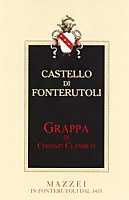
|
|
Grappa di Chianti Classico |
|
| Castello di Fonterutoli (Italy) | |
| (Distiller: Distilleria Giovi) | |
| Raw matter: Pomace of Sangiovese and Cabernet Sauvignon | |
| Price: € 26.50 - 500ml | Score: |
| This grappa is colorless, limpid and crystalline. The nose reveals intense and clean aromas of dried plum, violet, raspberry, black cherry, hazelnut and hints of hay, almost imperceptible alcohol pungency. In the mouth is intense with a dry taste, evident alcohol pungency which tends to dissolve rapidly and a low perception of sweetness. The finish is persistent and dry with flavors of plum and raspberry. This grappa is produced with the discontinuous system and it is shortly aged in barriques used for the aging of Chianti Castello di Fonterutoli. Alcohol 45%. | |
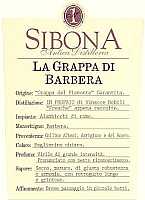
|
|
Grappa di Barbera |
|
| Sibona (Italy) | |
| Raw matter: Pomace of Barbera d'Asti and Barbera d'Alba | |
| Price: € 15.00 - 500ml | Score: |
| This grappa shows a pale golden yellow color, limpid and crystalline. The nose denotes intense, clean and pleasing aromas of vanilla, violet, caramel, plum, licorice, raspberry, blueberry, apple and hazelnut, almost imperceptible alcohol pungency. In the mouth is agreeable and intense with alcohol pungency which tends to dissolve rapidly, balanced sweetness, agreeable. The finish is persistent with flavors of caramel, plum and licorice. A well made grappa produced with discontinuous method in steam operated alembic stills and aged in small barrels. Alcohol 44%. | |
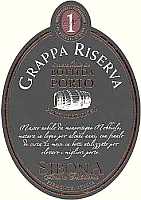
|
|
Grappa Riserva Botti da Porto |
|
| Sibona (Italy) | |
| Raw matter: Pomace of Nebbiolo | |
| Price: € 21.00 - 500ml | Score: |
| This grappa shows a deep amber yellow color, limpid and crystalline. The nose reveals good personality with intense, clean and pleasing aromas of praline, cinnamon, vanilla, raspberry, hazelnut, caramel, black pepper, licorice, pear, blueberry, black cherry and chocolate, elegant with almost imperceptible alcohol pungency. In the mouth is intense with pleasing and balanced sweetness, alcohol pungency which tends to dissolve rapidly, agreeable. The finish is very persistent with flavors of caramel, praline and licorice. A well made grappa produced with discontinuous method in steam operated alembic stills, aged for some years in casks and followed by 12 months of aging in casks used for the production of Vintage Port. 44%. | |
Wine Parade |
|
|
| The best 15 wines according to DiWineTaste's readers. To express your best three wines send us an E-mail or fill in the form available at our WEB site. |
| Rank | Wine, Producer | |
|---|---|---|
| 1 |
| Montepulciano d'Abruzzo Villa Gemma 1999, Masciarelli (Italy) |
| 2 |
| Harmonium 2001, Firriato (Italy) |
| 3 |
| Riesling Cuvée Frédéric Emile 1999, Maison Trimbach (France) |
| 4 |
| Turriga 1998, Argiolas (Italy) |
| 5 |
| Amarone della Valpolicella Classico Capitel Monte Olmi 1999, Tedeschi (Italy) |
| 6 |
| Brunello di Montalcino Prime Donne 1998, Donatella Cinelli Colombini (Italy) |
| 7 |
| Pinot Noir Napa 2002, Clos du Val (USA) |
| 8 |
| Chablis Grand Cru Les Clos 2002, Domaine Billaud-Simon (France) |
| 9 |
| Barolo Cicala 1999, Poderi Aldo Conterno (Italy) |
| 10 |
| Jerez Fino Tio Pepe, Gonzalez Byass (Spain) |
| 11 |
| Moscato d'Asti 2003, Vignaioli di S. Stefano (Italy) |
| 12 |
| Aglianico del Vulture La Firma 2000, Cantine del Notaio (Italy) |
| 13 |
| Château Roquebrun St-Chinian 2002, Cave de Roquebrun (France) |
| 14 |
| Palazzo della Torre 2000, Allegrini (Italy) |
| 15 |
| Notarpanaro 1999, Taurino (Italy) |
| |||||||
Privacy Policy | |||||||


| Copyright © 2002-2024 Antonello Biancalana, DiWineTaste - All rights reserved |
| All rights reserved under international copyright conventions. No part of this publication and of this WEB site may be
reproduced or utilized in any form or by any means, electronic or mechanical, without permission in writing from DiWineTaste. |